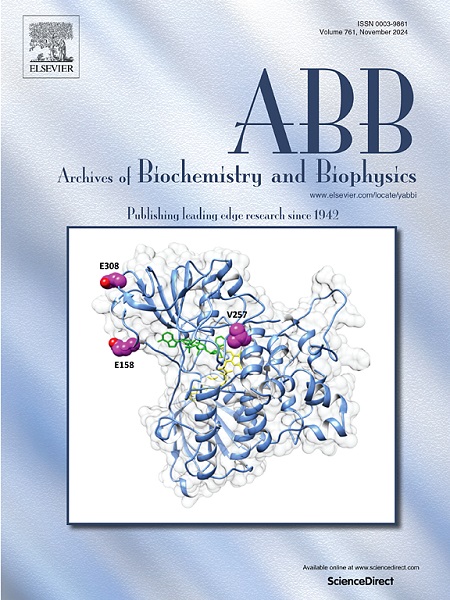人锰超氧化物歧化酶乙酰化保护酶的硝化和失活
IF 3.8
3区 生物学
Q2 BIOCHEMISTRY & MOLECULAR BIOLOGY
引用次数: 0
摘要
锰超氧化物歧化酶(MnSOD)是一种重要的酶,负责解毒线粒体中的超氧化物自由基,从而确保细胞内的氧化平衡。翻译后修饰(PTMs),如乙酰化和硝化,显著影响MnSOD的催化效率。过氧亚硝酸盐对MnSOD在酪氨酸34位点的特异硝化作用导致不可逆失活,这在多种病理中被广泛观察到。另一方面,MnSOD的乙酰化是一种可逆的修饰,可以调节酶的活性,并受到Sirt3蛋白的精细调节,Sirt3蛋白负责多种线粒体酶的去乙酰化。本研究的重点是Lys29乙酰化及其对酶活性的影响及其与过氧亚硝酸盐介导的Tyr34硝化作用的相互作用。通过分子动力学(MD)模拟,我们观察到Lys29的乙酰化部分阻断了通往活性位点的通道,降低了超氧化物的可及性。静电电位计算进一步表明,Lys29乙酰化减少了活性位点周围的正电荷,导致对超氧自由基的亲和力降低。布朗动力学(BD)模拟证实,在Lys29乙酰化后,酶对超氧化物的关联速率常数(kon)降低了50%。相反,Lys98乙酰化对kon的影响较小。体外研究也支持了我们的发现,表明乙酰化可能在过氧亚硝酸盐对MnSOD的不可逆失活中发挥作用,可能是通过立体阻碍Tyr34硝化作用。这些发现强调了乙酰化作为一种可逆保护机制的作用,可以调节应激条件下MnSOD对超氧化物和过氧亚硝酸盐的可及性。本文章由计算机程序翻译,如有差异,请以英文原文为准。

Human Mn-superoxide dismutase acetylation protects from enzyme nitration and inactivation
Manganese superoxide dismutase (MnSOD) is a critical enzyme responsible for detoxifying superoxide radicals in mitochondria, thereby ensuring oxidative balance within cells. Post-translational modifications (PTMs), such as acetylation and nitration, significantly influence MnSOD's catalytic efficiency. Site-specific nitration of MnSOD at tyrosine 34 by peroxynitrite leads to an irreversible inactivation, which has been widely observed in diverse pathologies. On the other hand, acetylation of MnSOD is a reversible modification that modulates the activity of the enzyme and it is finely regulated by the action of the protein Sirt3, responsible for the deacetylation of a wide variety of mitochondrial enzymes. This study focuses on Lys29 acetylation and its impact on the enzyme's activity and its interplay with peroxynitrite-mediated nitration of Tyr34. Through molecular dynamics (MD) simulations, we observed that acetylation of Lys29 partially obstructs the access channel to the active site, reducing superoxide accessibility. Electrostatic potential calculations further revealed that Lys29 acetylation diminishes the positive charge around the active site, contributing to decreased affinity for superoxide radicals. Brownian dynamics (BD) simulations confirmed a 50 % reduction in the enzyme's association rate constant (kon) for superoxide upon Lys29 acetylation. In contrast, Lys98 acetylation had a minor effect on kon. In vitro studies also supported our findings and showed that acetylation could play a role in the irreversible inactivation of MnSOD by peroxynitrite, likely by sterically hindering Tyr34 nitration. These findings highlight the role of acetylation as a reversible protective mechanism that can regulate superoxide and peroxynitrite accessibility to MnSOD under stress conditions.
求助全文
通过发布文献求助,成功后即可免费获取论文全文。
去求助
来源期刊

Archives of biochemistry and biophysics
生物-生化与分子生物学
CiteScore
7.40
自引率
0.00%
发文量
245
审稿时长
26 days
期刊介绍:
Archives of Biochemistry and Biophysics publishes quality original articles and reviews in the developing areas of biochemistry and biophysics.
Research Areas Include:
• Enzyme and protein structure, function, regulation. Folding, turnover, and post-translational processing
• Biological oxidations, free radical reactions, redox signaling, oxygenases, P450 reactions
• Signal transduction, receptors, membrane transport, intracellular signals. Cellular and integrated metabolism.
 求助内容:
求助内容: 应助结果提醒方式:
应助结果提醒方式:


